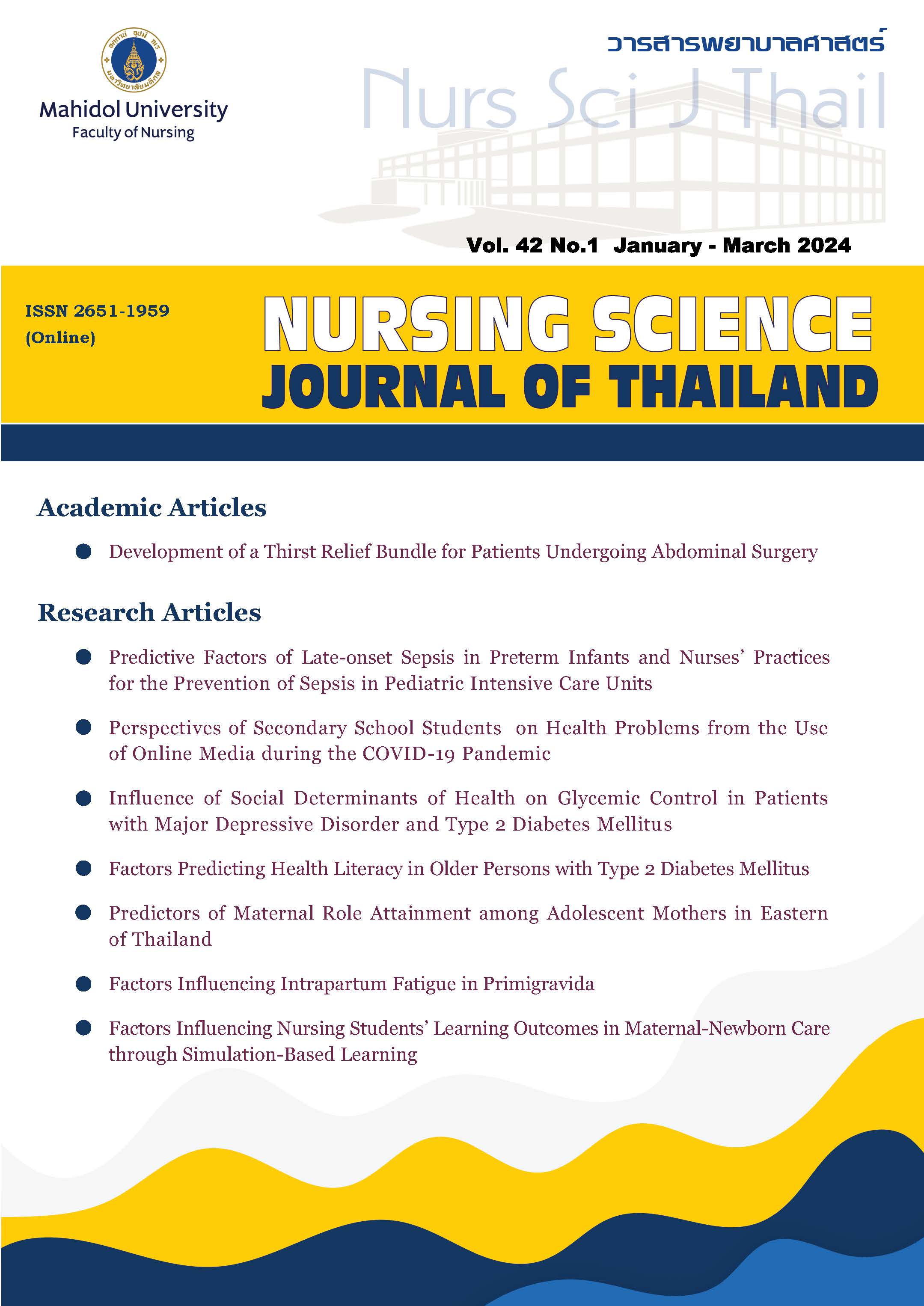Factors Influencing Intrapartum Fatigue in Primigravida
Main Article Content
Abstract
Purpose: This predictive research aimed to studying the influence of duration of labor, administration of oxytocin, anxiety, childbirth self-efficacy, and pain coping behaviors on intrapartum fatigue in primigravida.
Design: Predictive correlational design.
Methods: The samples consisted of 131 parturients admitted for delivery in the delivery room and postpartum ward at a super-tertiary care hospital in Bangkok. The instruments used for collecting data were a personal data form, the oxytocin administration record, Anxiety during Labor Questionnaire, the Thai Childbirth Self-efficacy Inventory, Pain Coping Behaviors Observation Form, and the Fatigue Questionnaire. Descriptive statistics, Pearson product moment correlation coefficient and multiple linear regression analysis were used to analyze data.
Main findings: The result showed that 77.1% of subjects had low score of intrapartum fatigue. The mean intrapartum fatigue score was 52.78 points, which was categorized as low levels of fatigue. Duration of labor, administration of oxytocin, anxiety, childbirth self-efficacy, and pain coping behaviors could together explain 20.4% of the variance in intrapartum fatigue among primigravida (R2 = .20) with at least one factor could significantly predict intrapartum fatigue in primigravida (F = 6.42, p < .001). The predictors included anxiety and pain coping behaviors ( = .26, t = 2.75, p < .01;
= - .26, t = -3.00, p < .01 respectively).
Conclusion and recommendations: Anxiety and pain coping behaviors could predict intrapartum fatigue in primigravida. Therefore, it is suggested that midwives and nurses should reduce anxiety related to childbirth and promote efficient pain coping behaviors for preventing intrapartum fatigue.
Article Details

This work is licensed under a Creative Commons Attribution-NonCommercial-NoDerivatives 4.0 International License.
Copyright Notice: Nursing Science Journal of Thailand has exclusive rights to publish and distribute the manuscript and all contents therein. Without the journal’s permission, the dissemination of the manuscript in another journal or online, and the reproduction of the manuscript for non-educational purpose are prohibited.

Disclaimer: The opinion expressed and figures provided in this journal, NSJT, are the sole responsibility of the authors. The editorial board bears no responsibility in this regard.
References
Delgado A, de Oliveira PdNF, de Góes PSA, Lemos A. Development and analysis of measurement properties of the "maternal perception of childbirth fatigue questionnaire" (MCFQ). Braz J Phys Ther. 2019;23(2):125-31. doi: 10.1016/j.bjpt.2019.01.004.
Pugh LC, Milligan R. A framework for the study of childbearing fatigue. ANS Adv Nurs Sci. 1993;15(4):60-70. doi: 10.1097/00012272-199306000-00007.
Tzeng Y-L, Yang Y-L, Kuo P-C, Lin Y-C, Chen S-L. Pain, anxiety, and fatigue during labor: a prospective, repeated measures study. J Nurs Res. 2017;25(1):59-67. doi: 10.1097/jnr.0000000000000165.
Cunningham FG, Leveno KJ, Bloom SL, Dashe JS, Hoffman BL, Casey BM, et al. Williams Obstetrics. 25th ed. New York: McGraw-Hill; 2018. 1328 p.
Isbir GG, Topcu B. The effects of intrapartum oxytocin induction on labor pain and fear of labor. Journal of Education and Research in Nursing. 2018;15(2):94-9. doi: 10.5222/head.2018.094.
Kernberg A, Caughey AB. Augmentation of labor: a review of oxytocin augmentation and active management of labor. Obstet Gynecol Clin North Am. 2017;44(4):593-600. doi: 10.1016/j.ogc.2017.08.012.
Chatchalawluck V. The effect of participation in a training program on self-management delivery skills among primiparas giving birth at the Maternal and Child Hospital, Health Promotion Center Region 4 in Ratchaburi [master’s thesis]. Bangkok: Mahidol University; 2000. 149 p. (in Thai).
Bostan FS, Kabukcuoğlu K. Factors relating to childbirth self efficacy among pregnant women: a CHAID analysis. J Obstet Gynaecol. 2022;42(7):2805-12. doi: 10.1080/01443615.2022.2109412.
Campbell V, Nolan M. ‘It definitely made a difference’: a grounded theory study of yoga for pregnancy and women's self-efficacy for labour. Midwifery. 2019;68:74-83. doi: 10.1016/j.midw.2018.10.005.
Asl BMH, Vatanchi A, Golmakani N, Najafi A. Relationship between behavioral indices of pain during labor pain with pain intensity and duration of delivery. Electron Physician. 2018;10(1):6240-8. doi: 10.19082/6240.
Kongsuwan W, Chatchawet W. Level of labor pain, level of labor pain behaviors, and cultural pain behaviors among first-time Indonesian muslim mothers. Open Journal of Obstetrics Gynecology. 2021;11(1):27. doi: 10.4236/ojog.2021.111004.
Pugh LC. Psychophysiological correlates of fatigue during childbirth [dissertation]. Baltimore: University of Maryland; 1990. 510 p.
Somjit T, Phahuwatanakorn W, Yusamran C. Intrapartum factors influencing onset of lactogenesis II after delivery. Journal of Nursing and Health Care. 2019;37(4):119-27. (in Thai).
Tanglakmankhong K. Childbirth expectations and childbirth experiences among Thai pregnant women [dissertation]. Portland: Oregon Health & Science University; 2010. 326 p.
Baosoung C. The effects of planned instruction and touching on anxiety level and coping behavior during labor [master’s thesis]. Bangkok: Mahidol University; 1983. 142 p. (in Thai).
Theerakulchai J. Factors related to fatigue and fatigue management among Thai postpartum women [dissertation]. Chiang Mai: Chiang Mai University; 2004. 187 p. (in Thai).
Hassanzadeh R, Abbas-Alizadeh F, Meedya S, Mohammad-Alizadeh-Charandabi S, Mirghafourvand M. Fear of childbirth, anxiety and depression in three groups of primiparous pregnant women not attending, irregularly attending and regularly attending childbirth preparation classes. BMC Womens Health. 2020;20(1):180. doi: 10.1186/s12905-020-01048-9.
Pinar G, Avsar F, Aslantekin F. Evaluation of the impact of childbirth education classes in Turkey on adaptation to pregnancy process, concerns about birth, rate of vaginal birth, and adaptation to maternity: a case-control study. Clin Nurs Res. 2018;27(3):315-42. doi: 10.1177/1054773816682331.
Selin L, Berg M, Wennerholm U-B, Dencker A. Dosage of oxytocin for augmentation of labor and women’s childbirth experiences: a randomized controlled trial. Acta Obstet Gynecol Scand. 2021;100(5):971-8. doi: 10.1111/aogs.14042.
Kissler KJ, Lowe NK, Hernandez TL. An integrated review of uterine activity monitoring for evaluating labor dystocia. J Midwifery Womens Health. 2020;65(3):323-34. doi: 10.1111/jmwh.13119.


